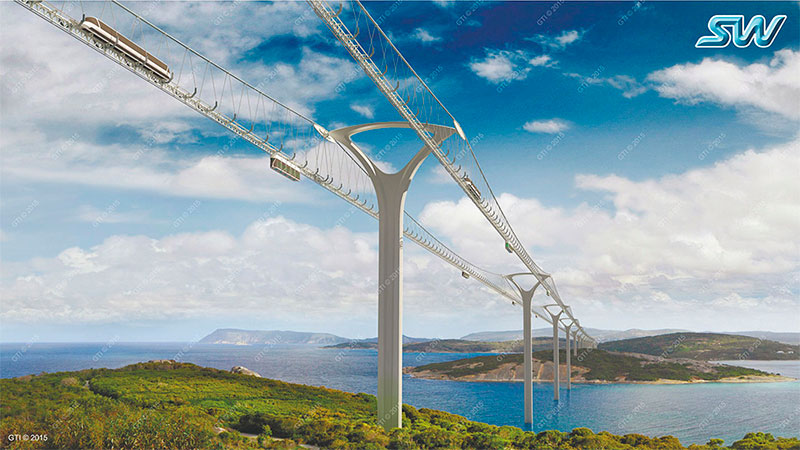
Unitsky String Technologies


 |
Unitsky String Technologies |


|
Site news
|
3 December 2015 |
|
Construction of high-speed route bypassing Russia 
On November 28 in Istanbul representatives of the major transport and logistics operators in Turkey and China, together with Kazakhstan, Azerbaijan and Georgia signed an agreement on consolidation of efforts to create a logistics system that will connect the West of China and Europe. The media dubbed this project as the "new Silk road". A specialist in the field of economics, business planning and strategic management Kirill Badulin analyzed the prospects of this decision and its further implications. You can read the expert's conclusions in his new article "Construction of high-speed route bypassing Russia". Prerequisites for the creation of the new Silk road is the increase in the volume of trade between Europe and Asia. According to the UN Conference on trade and development (UNCTAD), the volume of trade between major markets on the Eurasian continent by 2020 will grow by 1.5 times - from 800 billion USD in 2014 to 1.2 trillion USD. It is also expected that the trade turnover between China and EU will increase from 615 to 800 billion USD, between China and India from 66 to 92 billion USD by 2020. Now maritime transport dominates in the Intercontinental freight transportation between Asia and Europe, which accounts for more than 98% of cargo traffic. The length of the shortest sea route from China to Europe via the Suez Canal is 24 thousand km, and travel time is 35-40 days. One of the reasons for the delivery of goods from China to Europe and Asia mainly by sea transport is the lack of infrastructure for fast and cost-effective delivery of freight and passengers by road and rail. However, there are currently a number of road and rail corridors, which would be able to ensure the delivery of goods from China to Europe by land, in particular:
Transport corridors can significantly reduce the distance on the East - West route and the timing of freight deliveries. However, the Trans-Siberian railway, despite the high throughput (100 million tons per year) is the busiest, therefore, it does not seem possible to increase the cargo turnover between China and Europe through it. The TRACECA corridor is underutilized due to the large number of transshipments in ports (on the Black and the Caspian seas), which increases the time and reduces the efficiency of transportation. Considering all the above, the most promising direction for the growth in trade between Europe and China becomes the development of the above-mentioned Trans-Asian corridors (Northern, Central and Southern). Meanwhile, China is actively investing in transport infrastructure to transit cargos to Europe overland. Consequently, this means more opportunities for countries through which the main traffic flows will pass: China, Kazakhstan and Russia. One of the factors limiting the growth of rail transit through Kazakhstan and Russia is the difference in rail track gauge: in Europe, China and most countries of the world it is 1,435 mm, in Russia and Kazakhstan - 1,520 mm; this entails the need to change wheels and to reload railway cars at the border. In this regard, the Chinese corporation China Railway Corp has put forward the project of construction of a high-speed road along the route Urumqi (China) - Almaty - Bishkek - Tashkent - Samarkand - Ashgabat - Tehran. According to the statement of the Chinese side, the project will provide an annual turnover of more than 2.5 trillion USD. A crucial part of the project is the actual continuation of the railway networks of China to the Middle East and Turkey with the railway gauge of 1,435 mm. Chinese trains thus will be able to move without stopping and overloading from any city in China up to the border of Turkey and then across Europe, where track width is also 1,435 mm. The speed of transferring passengers will be 250-300 km/h, cargo - up to 120 km/h. It should be noted that the route of this railway almost entirely (except for the tracks across Turkmenistan and Iran) coincides with the route of the Southern Trans-Asian corridor. We can assume that China is trying to strengthen its geopolitical position in the Central Asian States by means of the construction of this railroad. However, the solution is not optimal and in the future can bring about a number of serious problems from the point of view of ecology and freight throughput. In this regard, it would be appropriate to offer a much more effective solution in the form of a multifunctional SkyWay high-speed route arranged at the "second level". For example, the cost of building high-speed tracks by the SkyWay technology will be 5-7 times cheaper than analogical routes of other manufacturers (moreover, the cost of building rails on the elevated ways would be ten times more expensive). In addition, the annual volume of traffic along the SkyWay tracks may be up to 500 million passengers and 500 million tons of cargo per year, which cannot be provided by any other transportation system (thus, the Trans-Siberian railway transfers only 100 million tons of cargo per year). Reference The cost of 1 km of the SkyWay high-speed route, depending on the terrain conditions of the route and the chosen solution, will be from 5 to 10 million USD, while the cost of similar high-speed tracks from other transport systems will be: · Chinese production - from 24 million USD for 1 km; At the same time, operating speed of competing high-speed systems is 300-350 km/h, while the SkyWay high-speed intercity system reaches 400-450 km/h (design projected speed is 500 km/h). 
The article about the China Railway Corp project also noted that in parallel a high-speed highway Moscow - Beijing with the length of about 8 thousand km is designed. It will pass on the route Moscow - Kazan - Yekaterinburg - Astana - Urumqi - Beijing (work on the design of this route on the section Moscow - Kazan started in 2015). According to the estimates of the "Russian Railways Corp.", its cost will be about 7 trillion Russian roubles (including the cost of the Russian section - about 2.5-2.8 trillion Russian roubles). In case of building the Moscow - Beijing route by SkyWay technologies dozens of billions of dollars could be saved. Another important aspect of the construction of high-speed railways according to the traditional technology in the mounds is that they cause very serious damage to the environment, disturb the motion of surface and ground waters, habitats and migration routes of animals and birds. Earthen embankment of railroads, especially high-speed ones, becomes an insuperable low-pressure dam: a swamp is on the one side of embankment, and desertification on the other. For these reasons, countries involved in the active construction of high-speed railways according to the traditional technology, could soon face serious problems, since it will have a negative impact on the soil and agriculture. In this regard, the beginning of building high-speed railways in embankments in Russia and Central Asia, which are characterized by a high degree of environmental pollution, can cause worsening of the environmental situation in these countries. In addition, the SkyWay transport systems would allow to save billions of tons of fuel, which also has a direct impact on the environment. And this will inevitably affect the health and welfare of future generations. On the one hand, the construction of the high-speed route from China to Turkey through Central Asia and Iran may in part have a negative impact on the development of Russian Siberia and the Far East. On the other hand, it can be argued that the Chinese investments in the development of transport infrastructure in Central Asia and the Middle East in the long term can bring to the countries of these regions not only advantages, but also serious problems. Russia has no need to repeat the mistakes of others, therefore it is necessary to bet on the development of innovative transport technologies that will lead the country to economic growth and prosperity without damaging the environment and the quality of people's life. |
|
© 1977—2017 Anatoly Yunitskiy. All Rights Reserved. |
||